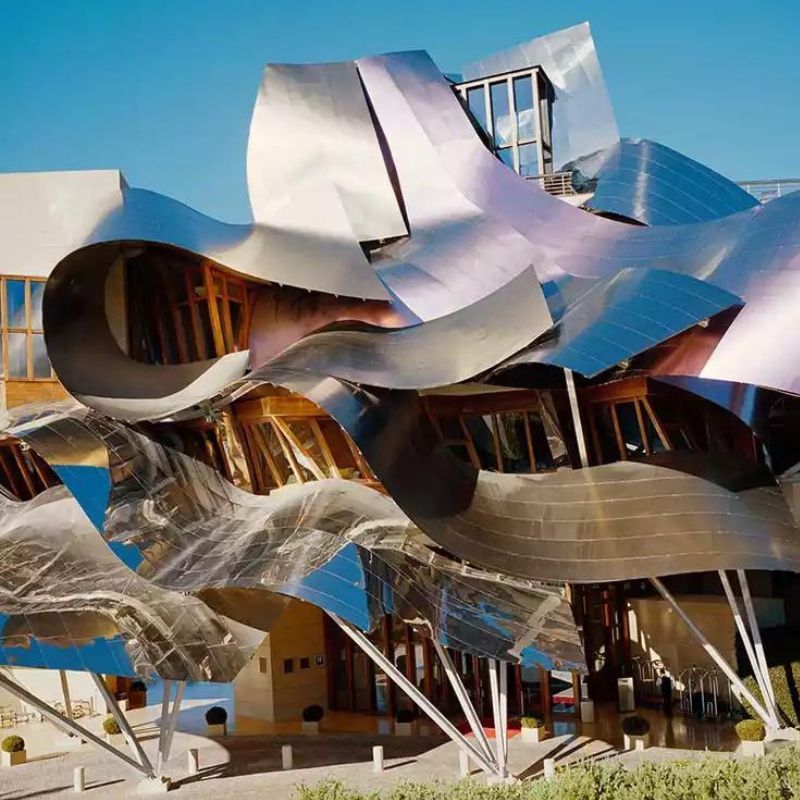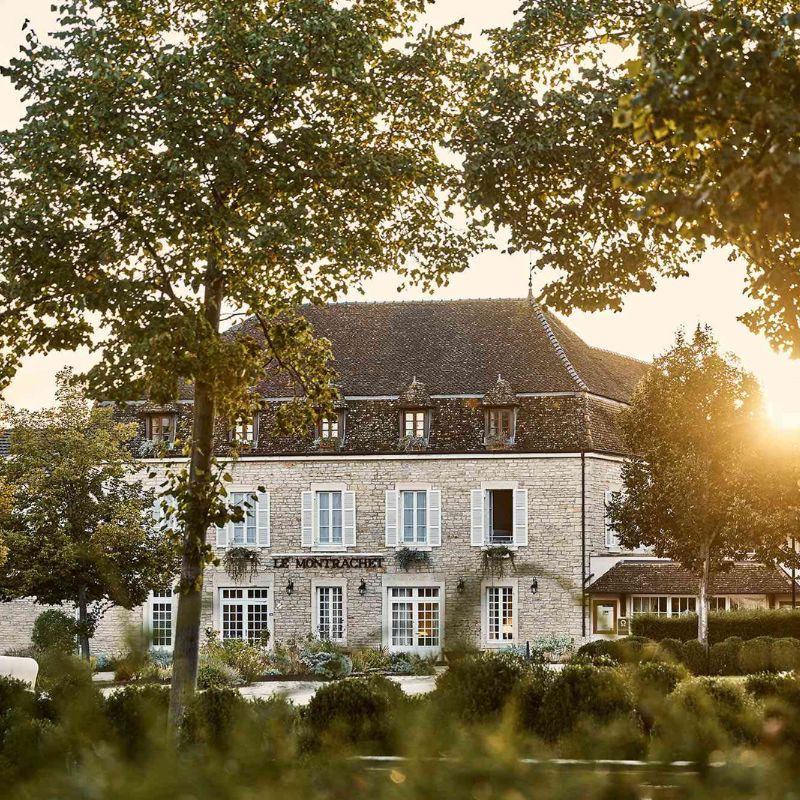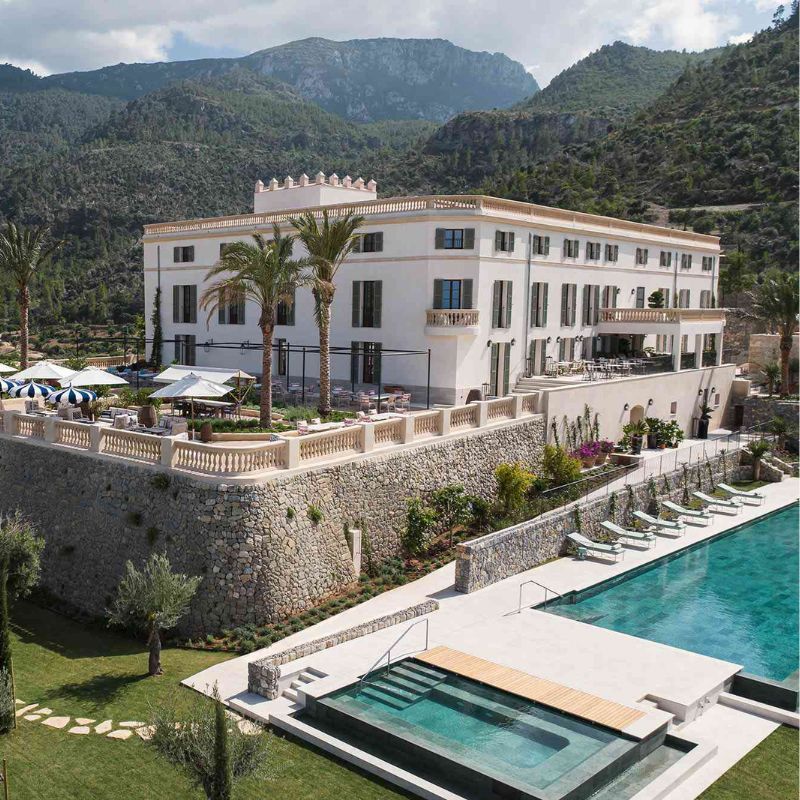
I fell asleep as my driver pulled away from Barcelona-El Prat Airport — and woke up an hour later to vineyard-lined country roads.
We crossed a stone bridge that looked straight out of Game of Thrones, drove through the photogenic medieval town of Torroja, which is built directly into a cliff, and continued along winding roads until a pop of pink came into view: the deep coral face of Gran Hotel Mas d’en Bruno.
This luxury hotel is the perfect stay in Priorat, Spain
Gran Hotel Mas d’en Bruno

- A member of Relais & Châteaux, the new hotel is one of the most luxurious stays in Priorat, Spain, a wine region on the rise.
- There are multiple swimming pools, including an outdoor wine bottle–shaped pool overlooking grape vines and stunning warm pools in the spa.
- The restaurant might be headed for a Michelin star under the helm of young chef Josep Queralt, who serves elevated Catalonian fare and inventive tasting menus at dinner.
The hotel got more intriguing as we drove closer: a 500-year-old building, rows of arched windows, cantilevered stone, terra-cotta shingles, French balconies, and a two-toned coral-beige façade, all tidily encircled by a dining terrace abutting rows of Grenache grapes.
I arrived famished and beelined to the restaurant — very likely on its way to earning Priorat Spain’s second Michelin star. After a post-red-eye glass of cava from the nearby Penedès region and a plate of delicately grilled cod under the Catalonian sun, I was revived.
Really, I’d come to this new luxury hotel in Spain to eat and drink. Mas d’en Bruno is a new Relais & Châteaux, and the group doesn’t put its stamp of approval on a hotel unless the food is exceptional. Spoiler: it is. I reached culinary nirvana at lunch on Saturday, when I was served what can only be described as a flight of carbs — first, fideuà, a chopped pasta dish in the paella family, with roasted garlic and cuttlefish. Next, arroz negro, served in a classic red paella pan with mussels, alongside a chilled Priorat Grenache and cariñena blend. It was so sensational that I asked for the last rice dish on the menu when I returned the next evening; this one was a classic, saffron-rich paella with Tarragona prawns, spiny lobster, and piquillo peppers that I devoured down to the socarrat (that is, the caramelised rice stuck to the bottom of the pan).
The four days I spent in Priorat this fall — wining, dining, and sipping espresso on Mas d’en Bruno’s terrace while wearing excellent sweaters — is an experience someone could have had centuries ago, but not 35 years ago. Priorat was once a country seat for the Barcelona elite and a fine wine region, but phylloxera (a pest that destroys grapevines) swept through in the early 1900s, depleting the wine industry. Producers were forced out of business, farmers went broke, and the skilled winemakers left. In the 1980s, a few pioneers eager to restore Priorat’s legacy came to rebuild the wine industry — like the Pastrana family, owners of Clos de l’Obac, now one of the region’s most celebrated wineries.
As the wine scene grows, the restaurants follow, and travellers are starting to take note. The new Gran Hotel Mas d’en Bruno, which opened in May 2023, is a gateway to this inviting, storied wine enclave. Here, is my review of the hotel and why it’s the perfect home base to explore this lesser-known Spanish wine region.
The rooms

Designed by Barcelona architecture firm Estet Design, Mas d’en Bruno’s 24 rooms all capitalise on its location, offering astounding vineyard views. The room design plays with natural wood and elegant rounded edges (seen on the bed’s headboards and the curved “maxibars”). Local materials are used wherever possible; the lamps are made of Catalonia-sourced alabaster and all the marble comes from Spain. “Some of the rooms have terraces, some have gardens, some have balconies. What we try to do is have a hotel that gives you a different experience every time you come, if you want it,” said David Stein, owner of Mas d’en Bruno. “Each room is designed differently — some have dining tables, some have fireplaces, some have handmade Roman tubs.”

My room had three massive curved windows with French balconies overlooking the wine bottle-shaped concrete pool and a bathroom with a massive burgundy wine-coloured marble sink and a stand-alone soaking tub. I told Stein I wanted the coffee table, covered in opaque marble, for my living room at home, and he assured me that most of the furniture was handmade by Estet Design and would, in the future, be available for guests to buy. Of the 24 rooms, 13 are in the Masia (main house). The last 11 are in the atelier, a separate building next to the pool, and each comes with a huge terrace set in the middle of vines with an outdoor fire pit.
Food and drink

On Friday night, I sat down with Stein to try Chef Josep Queralt’s nine-course winter tasting menu. We started with amuse-bouches served on a tree figurine the chef had built himself, before moving into appetisers — goat cheese jelly on an herb cookie, over a tangle of greens from Mas d’en Bruno’s garden, and cured egg yolk on a mushroom duxelle. The artistry of chef Queralt peaks at dinner, as he flawlessly stuffs sea robin with mussels and prawns, and presents each course with stories of foraging for mushrooms on the hotel grounds.
The dining room was buzzing — and somehow, everyone knew each other. At the table near the bar sat Elizabeth Hecker, who just wrote the book “Ethos Priorat.” She led me two tables over to meet the winemakers behind Celler Família Nin-Ortiz, who were celebrating an anniversary (and have a 100-point wine on Wine Advocate). In Priorat, where the wine and hospitality community feels tight-knit and enticing in a way only a locale just showing up on US wine lists can, this restaurant made me feel like I belonged.

By day, the restaurant is called Tarraco and serves a mélange of Western Europe fare. One afternoon, I sampled foie gras ravioli with hazelnut cream and grilled heads of romaine with an unctuous, anchovy-heavy dressing. In the evenings, the restaurant becomes Vinum and serves both the chef’s tasting menu and à la carte offerings. Stein wanted to have a restaurant where guests could have a luxurious meal without needing to leave the hotel after a long day of hiking, wine tasting, or both.
Experiences and amenities

My favourite amenity at this luxury hotel was, of course, the wine bottle–shaped outdoor pool. Pools tend to be a rarity in Priorat — though, admittedly, five-star hotels are a rarity in Priorat, so there may be a correlation. I thoroughly enjoyed my time on the daybeds of an adjacent sundeck, where Mas d’en Bruno hosts periodic yoga classes. The hotel also has four electric bikes that guests can use (complimentary) at any time. Still to come is a poolside restaurant that will bring in nearby winemakers to host tastings on-site.

As for experiences the hotel can create for you, the possibilities are endless. Speak with Natalie in guest services to arrange wine tastings, tours of must-see villages nearby, and hiking and climbing in Montsant Natural Park (don’t miss lunch and a stroll through Siurana after your hike). The hotel arranged for me to visit Clos de l’Obac in Gratallops. Owned by the aforementioned Pastrana family, who is largely credited with reigniting the fine wine scene in the ’80s, Clos de l’Obac’s Wine Spectator–endorsed reds show off the best local grapes — namely, cariñena and Garnacha (or, as you might know them, carignan and grenache). Later that same day, I got a crash course in Catalonian vermut. When there was a mass winemaker exodus post-phylloxera, the farmers who stayed formed a wine co-op. The one I visited, Ètim, is in an impressive cathedral designed by a pupil of Gaudí’s and produces a particularly herbaceous Vermut Falset. There’s an entire trail of wine cooperativas (also sometimes called wine cathedrals because of the majestic structures in which they’re housed). Finally, I adored my time at Perinet Winery, where I took a tour of the gorgeous vineyards and tasted wine out of the barrels with the winemaker.
Shop the best travel experiences here
The spa

I visited the spa shortly after my arrival. There is just one treatment room, where I slipped into a jet lag–induced trance during my relaxation massage. But it was really the luxurious baths that sold me on the spa; you can even reserve them for some privacy (complimentary). “The area the spa is in was once an olive press,” Stein said. “When we put the spa in there, we renovated and restored the elements of the olive press. We had an archaeologist come in for four or five months to restore [parts of the olive press and the stone walls]. It’s symbolic of what used to be in that room.”
The centuries-old stone walls make the spa feel like upscale Roman baths. I relished having the whole space to myself as I waded into the massive main pool — the modern fountain spouting a sheet of water that looks like an anachronism next to the restored olive press — before soaking in the black-tiled hot tub.
Family-friendly offerings
Rooms can be outfitted for families — I toured one with a crib, for example, and there are adjoining suites with a shared living room that is perfect for larger families. That said, if you’re looking for a vacation with a kids’ club and unlimited children’s activities, this probably isn’t it. I recommend waiting until your children are college-age, then bringing them to experience true European wine country culture.
Accessibility and sustainability
Many (though not all) rooms in the main house are wheelchair-accessible thanks to the elevator, which goes to all three floors. However, the atelier, all on one level and with 11 rooms featuring spacious terraces, maybe the best choice accessibility-wise because there are no stairs.
Location
This luxury hotel in Spain is 83 miles (133.57 km) from Barcelona-El Prat Airport. You can easily rent a car and drive yourself there — they drive on the right side of the road. The Priorat region is best seen by car, so renting one is a smart idea. That said, you can also work with the hotel to arrange a car from the airport and transportation to all the activities Mas d’en Bruno will help you set up.
Priorat is in the state of Catalonia and the province of Tarragona. (Catalonia is home to four provinces: Barcelona, Girona, Lleida, and Tarragona.)
How to get the most value out of your stay
The most affordable rooms at the Relais & Châteaux–approved hotel are junior suites, which start at USD 427 (INR 35,595) when booked early on the website (i.e., several months in advance) for a weekend in the fall. The most expensive room in the house is Bruno’s Suite, which starts at USD 1,260 (INR 1,05,035) when booked early for an October stay. All guests are offered a welcome drink, early check-in and late checkout (if available), and free room upgrades (if available). June through August tend to be high season in Catalonia, so consider going in May, September, or October to potentially find lower prices.
Book your stay at Gran Hotel Mas d'en Bruno via Booking.com
(Hero and feature image credit: Maya Kachroo-Levine/Travel + Leisure)
This story first appeared on travelandleisure.com
All currency conversions were done at the time of writing
Related: Bookmark This: Hidden Gems Of Spain Nobody Talks About!












